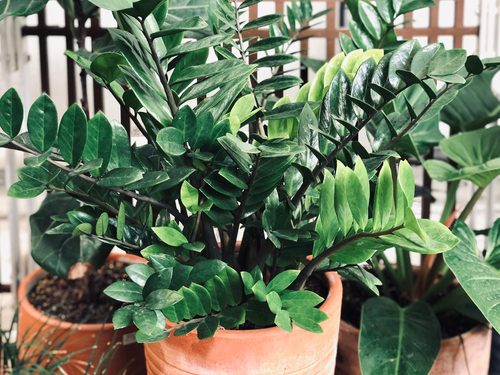The ZZ plant is the queen of indoor plants. This is because it thrives even with neglect or little care. Its rhizomes stretch to store water for dry days, and its stalks proudly shoot up towards the skies. So, when you notice the plant start to droop, it raises questions like, “Why is my ZZ plant drooping?”
If your ZZ plant is drooping, it could be due to a range of causes including overwatering, underwatering, lack of nutrients, pests, or disease, but this article offers solutions to help revive your plant’s health.
The ZZ plant does not bow easily to disease or pest infestation and thrives in the harshest conditions. Yet, even the sturdiest plants sometimes break down and need help getting healthy again. This article points you to some of the common causes of ZZ plant drooping and guides you on steps to take when this happens.
Why Is My ZZ Plant Drooping? Common Causes and Treatments

The causes of your ZZ plant drooping revolve around extreme environmental conditions and poor grooming routines. These cause root rot, stalk wilt, or the general inability of the plant to utilize nutrients. Hence, the plants may get sick from malnutrition, toxicity, or stress.
The significant causes of drooping of ZZ plants include:
1. Low Humidity
ZZ plants do well with little water supply but become dehydrated when you forget to water them for long. This prevents them from using the available nutrients and may cause malnutrition. This will then present as drooping and wilting of stalks.
The leaves will also dry and curl up. This causes them to look sickly and weak.
Nursing Tips
To make them healthy, you must supply sufficient water to the dry potting soil. It would help if you did this at intervals to prevent flooding of the roots. You can also trim off dead stalks and leaves to allow new growth.
2. Overwatering

The native environment of this houseplant is semi-arid, and so the plant is adapted for low water supply. However, its large rhizomes hold sufficient fluid to carry the plant for days. So, it prefers dry days between watering to enable the plants to utilize the root’s water stores.
Overwatering also causes root rot and decay, as waterlogged soil causes flooding of roots. When this happens, the roots cannot take up nutrients from the soil. This will cause malnutrition in the entire ZZ plant and will present as drooping of the plant.
Another effect of overwatering is that it depletes the soil’s aeration and presents anaerobic bacteria with optimal growth conditions.
Nursing Tips
The first step to restoring the ZZ plant’s health is draining the soil’s excess water. You can do this by drilling holes in the plant pot to create a path for drainage. Next, you may need to trim off the rotting roots to prevent the spread of decay to healthy root parts.
To prevent flooding, here is a list of alternatives to direct watering of your ZZ plant:
- Use a humidifier to spritz water on the plant stalks
- Place a stone bed underneath the plant pot
- Create a watering routine that allows some dry days to enable the plant to utilize its water stores
- Avoid using clay soil as potting soil
3. Exposure to Direct Sunlight

When you expose your ZZ plant to direct sunlight, it may experience sunburn and wilt from the harsh rays. Therefore, you will notice that they begin to curl or grow away from the light source. In the event of extensive sunburns, the damage will cause the plant stalk to die and droop.
Nursing Tips
The best way to tackle exposure to excessive sunlight is to relocate the ZZ plant to other parts of the house. If this is impossible, you can get dark drapes to reduce the light’s intensity.
4. Fertilizer Toxicity
Most commercial fertilizers contain salts that may turn the potting soil acidic. This occurs when you put excess amounts of fertilizers into the soil. An acidic soil chokes the roots and causes them to shrink. This disallows the roots from taking up nutrients from the soil.
Eventually, the ZZ plant gets sick from malnutrition and starts to droop. Fertilizer toxicity can also cause wilting of the plant and lead to irreversible death if you do not act promptly.
Nursing Tips
You may need to repot the ZZ plant in viable soil. To do this, break the soil around the plant root. This prevents damage to the roots as you tug them away from the soil. Carefully examine the roots and trim off rotten or wilted roots. Plant the plant in viable soil and apply sufficient amounts of water. You can use ZZ plant fertilizers or compost manure to aid your plant’s growth.
5. Shock
The ZZ plant may droop immediately after transplanting to a bigger pot. This occurs as it adjusts to its new environment and adapts to the new conditions. A plausible explanation is that the roots are trying to find their place in the new soil. This might take a while, and the nutrient uptake may be slow. This might cause transient malnutrition to the plants and lead to drooping. However, with time, they will settle in and blossom.
Nursing Tips
As a rule, please do not disturb the ZZ plant as it settles into its new environment. If you can help it, transplant your plant during the colder months. This is because transplanting ZZ during the summer causes the roots to dry faster and may take longer to adapt to the new soil.
6. Poor Lighting

Very low light causes stunting of the ZZ plant. This is because sunlight is essential for photosynthesis. The old stalks may grow slowly in a poor light source. But new shoots need a moderate supply of sunlight to grow and become beautiful. So, the new shoots will droop and die with poor lighting.
Nursing Tips
If your home does not allow sufficient sunlight to reach your ZZ plant, you could augment the light supply using LED growth lights. You can only put the plant on the window pane or use fluorescent lights.
Fun Fact
The botanical name of the ZZ plant is Zamioculcas zamiifolia. This plant originates from South Africa, which is a semi-arid region. However, because the plant’s name is a mouthful, plant parents nicknamed it “the ZZ plant.”
Summary
The ZZ plants are the least picky of all houseplants. This makes them a popular favorite among houseplant parents. They do not need tedious grooming conditions and will thrive in almost all climes.
So, you know that your plant is unhealthy and sad when it starts to droop. Yet, with loving care and patience, you can nurse your ZZ to health in short periods. This article has listed the common causes of drooping in your ZZ plants and answers the question, “why is my ZZ plant drooping?”
Using the information here, you may never have to experience your ZZ drooping again.
Also read: Why Are My Avocado Tree Leaves Drooping
Frequently Asked Questions
Why are my ZZ plant stems falling over?
ZZ plants love little water supply and thrive well in arid conditions. Yet, they are plants and need water to live on. So, if you are too cautious about flooding your plant, your ZZ may die of dehydration. The most common signs of dehydration are curled leaves and drooping stems.
Correct this fault by watering your ZZ accordingly when you see these signs.
Is your ZZ plant drooping?
This is a nightmare for all ZZ plant parents because it means your ZZ is sick. You ZZ may have drooping stalks or leaves. The causes are diverse but easy to handle. And with the right therapy, your ZZ is sure to thrive again.
Why are my ZZ plant leaves turning yellow?
When ZZ leaves turn yellow, it might be that the roots are rotting or sick. A common cause of this is flooding. Flooding disallows the roots from taking up nutrients from the soil, and the plant slowly dies from malnutrition. It also creates a suitable environment for anaerobic bacterial growth.
This is harmful to the plant as it is prone to infection due to its weakened immunity and the presence of bacteria. So, you may lose the plant if you do not act promptly and correctly.
Conclusion
The ZZ plant is hardy and thrives even in harsh conditions. So, it is the perfect houseplant for every household. Yet, you must know the common predators that haunt this plant and be ready to tackle them immediately they show up.
If you want siblings for your ZZ plant, it is best to find out about them. Arming yourself with the right gardening tips will help you to avoid rookie mistakes on your journey as a plant parent.

Hey, I’m Lisa and I’ve been an avid gardener for over 30 years. I love writing, talking and living in the garden! Feel free to connect with me on my socials below

